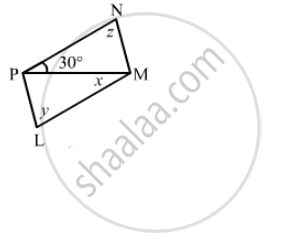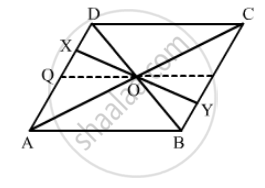Advertisements
Advertisements
प्रश्न
The sum of two opposite angles of a parallelogram is 130°. Find all the angles of the parallelogram.
उत्तर
\[\text{ Let the angles be A, B, C and D }. \]
\[\text{ It is given that the sum of two opposite angles is } 130°. \]
\[ \therefore \angle A + \angle C = 130°\]
\[\angle A + \angle A = 130° \left( \text{ opposite angles of a parallelogram are same } \right)\]
\[\angle A = 65°\]
\[\text{ and } \angle C = 65°\]
\[\text{ The sum of adjacent angles of a paralle\logram is } 180° . \]
\[\angle A + \angle B = 180°\]
\[65°+ \angle B = 180°\]
\[\angle B = 180°- 65°\]
\[\angle B = 115°\]
\[ \angle D = 115°\]
\[ \therefore \angle A = 65°, v\angle B = 115°, \angle C = 65° \text{ and } \angle D = 115° .\]
APPEARS IN
संबंधित प्रश्न
The following figure is parallelogram. Find the degree values of the unknown x, y, z.

Two adjacent sides of a parallelogram are 4 cm and 3 cm respectively. Find its perimeter.
The perimeter of a parallelogram is 150 cm. One of its sides is greater than the other by 25 cm. Find the length of the sides of the parallelogram.
Diagonals of parallelogram ABCD intersect at O as shown in the following fegure. XY contains O, and X, Y are points on opposite sides of the parallelogram. Give reasons for each of the following:
(i) OB = OD
(ii) ∠OBY = ∠ODX
(iii) ∠BOY = ∠DOX
(iv) ∆BOY ≅ ∆DOX
Now, state if XY is bisected at O.

Which of the following statement is true for a rhombus?
Two of its angles are at right angles
Which of the following statement is true for a rhombus?
It is a parallelogram.
Which of the following statement is true for a rhombus?
It is a quadrilateral.
If all pairs of adjacent sides of a quadrilateral are congruent then it is called ______.
A quadrilateral whose all sides are equal, opposite angles are equal and the diagonals bisect each other at right angles is a ______.
If all sides of a quadrilateral are equal, it is a ______.
